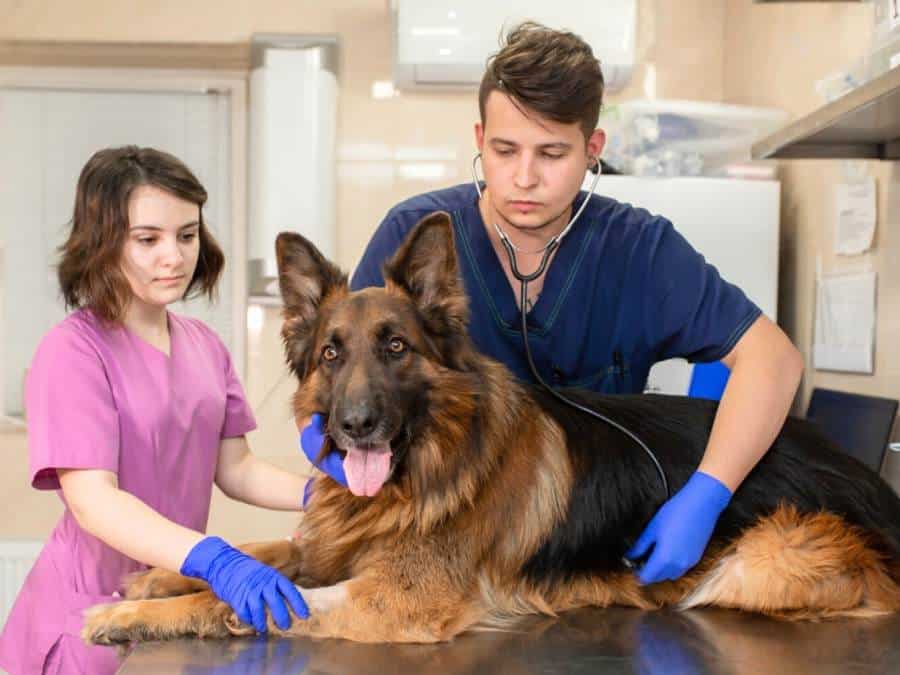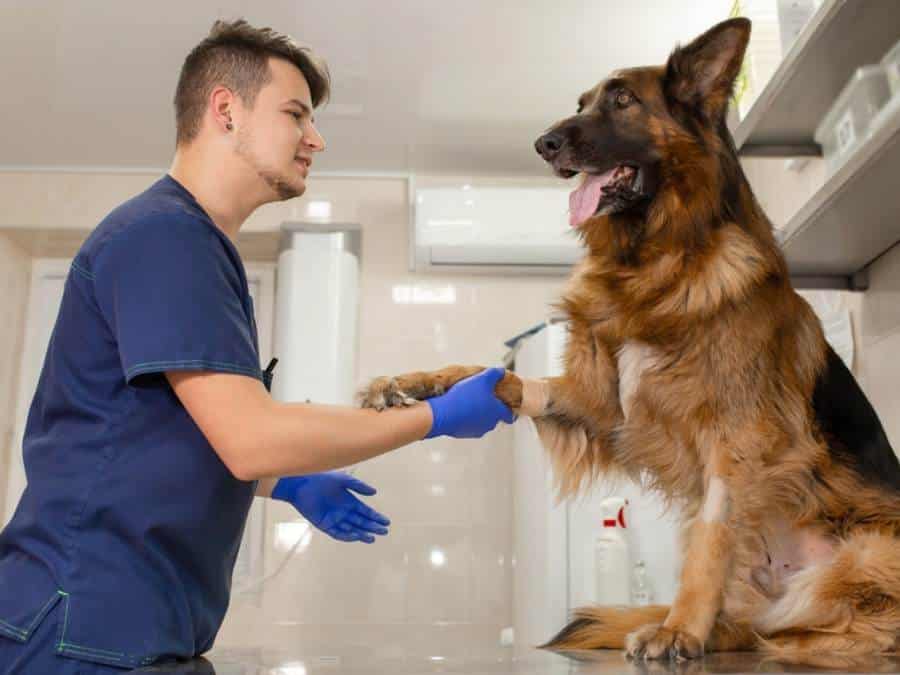Pyoderma is a common skin condition that affects German Shepherds, causing discomfort and irritation. It is characterized by a bacterial infection that can occur in various forms, such as impetigo or deeper infections involving the hair follicles.
Dogs of all ages, from puppies to adult dogs, can develop pyoderma.
Recognizing the signs of pyoderma early on is crucial for effective management and prevention of further complications.
So in today’s article, we will explore how pet parents like us can identify this condition in their GSDs and provide them with the necessary care they need to alleviate their discomfort.
What is Pyoderma in German Shepherds
Pyoderma in German Shepherds is characterized by the presence of pus-filled lesions on the skin, typically caused by bacterial infections. Pyoderma can be caused by different types of bacteria, with Staphylococcus intermedius being a common culprit. (Source)
According to Dr. Amelia White, DVM, an associate clinical professor of dermatology at the Auburn University College of Veterinary Medicine, “These bacteria typically reside on the skin’s surface without causing any problems, but they can multiply and lead to infection if the bacteria get into the dog’s body.”
The presence of bacteria triggers an inflammatory response in the dog’s body. The immune system sends white blood cells to fight off the infection, resulting in redness, swelling, and discomfort for our furry friends.
These infections can occur due to various factors such as allergies, hormonal imbalances, immunodeficiency, or even underlying health issues.
Pyoderma can occur at any age but is more commonly seen in younger German Shepherds.
The term “pyoderma” is derived from the Greek words “pyo,” meaning pus, and “derma,” meaning skin.
Where does pyoderma occur in a GSD’s body?
Pyoderma is not limited to specific areas of a dog’s body; it can occur anywhere there is skin present.
Common sites for pyoderma include areas with folds or creases like armpits, groin region, facial folds, or areas prone to moisture retention such as the paws or ears.
The skin around the anus is another common site for pyoderma, especially in dogs with loose or wrinkled skin in that area.
The underside of the abdomen, particularly in the area between the hind legs, can be susceptible to pyoderma
Pyoderma can occur on the back and trunk, and it may be more generalized in some cases.
German Shepherds are particularly prone to developing pyoderma due to their unique genetic makeup and susceptibility to certain environmental triggers.

How to Treat German Shepherd Pyoderma at Home?
If your dog has a mild infection and you can’t bring them to the vet, there are a few things you can try at home. Sometimes, these methods can be effective.
Wash your dog with an Antibacterial Shampoo
According to this study, shampoos containing Chlorhexidine have been shown to improve pyoderma in dogs.
- Thoroughly wet your dog’s coat, and then apply the Douxo S3 PYO Shampoo, making sure to lather it well over the affected areas. This shampoo contains both Chlorhexidine as well as Ophytrium.
- Allow the shampoo to sit for the recommended time before rinsing thoroughly.
- Be gentle during the bathing process to avoid causing additional irritation.
Give your GSD an Antihistamine
- Antihistamines can help manage itching and reduce inflammation associated with allergic reactions.
- Consult with your veterinarian to determine the appropriate antihistamine and dosage for your dog.
- Administer the medication according to your vet’s recommendations.
- Common antihistamines for dogs include cetirizine, diphenhydramine, and loratadine.
- Ensure you’re using a formulation without additional active ingredients that may be harmful to dogs.
Apply coconut oil to the affected areas
- Coconut oil has natural antimicrobial properties and can be soothing for irritated skin.
- Apply a small amount of this organic, unrefined coconut oil to the affected areas.
- Gently massage the oil into the skin to promote absorption.
- Coconut oil can be applied a few times a week as part of your dog’s skincare routine.
Start feeding your dog Omega-3 Fatty acids
Omega-3 fatty acids, found in fish oil supplements, have anti-inflammatory properties that can benefit skin health.
Omega-3s can have an impact on both infection and the healing of wounds, making them beneficial for treating pyoderma in German Shepherds.
However, it is important to note that relying solely on this product for healing pyoderma is not recommended. It should be used in conjunction with the other methods mentioned above.
Here’s a good Omega-3 supplement I found on Amazon, it’s specially made for large dogs.

Symptoms of Pyoderma in German Shepherds
Pyoderma, a common skin condition in German Shepherds, can manifest through various signs and symptoms.
Here are common symptoms associated with German Shepherd pyoderma:
1. Redness and inflammation: One of the first signs of pyoderma is redness and inflammation on the skin. This can occur in localized areas or may be more widespread.
2. Itching and scratching: Dogs with pyoderma often experience intense itching and may scratch or lick the affected areas excessively. This can lead to further irritation and even secondary infections.
3. Pustules and pimples: Pyoderma is characterized by the presence of pustules and pimples on the skin. These may be filled with pus and can be painful to the touch.
4. Hair loss: As the condition progresses, affected dogs may experience hair loss in the affected areas. This can result in patchy or thinning fur, particularly in severe cases.
5. Foul odor: Pyoderma can cause a foul odor to emanate from the affected areas of a dog’s skin. This odor is often described as musty or unpleasant.
6. Circular crusts or scaly skin: According to VCA Hospitals, the skin affected by pyoderma may become crusty or scaly in texture. This can make it appear rough and uneven.
7. Swelling: Swelling may occur in the affected areas, especially if the infection is more severe or if there is an underlying abscess.
8. Hot spots: Hot spots, also known as acute moist dermatitis, can develop as a result of pyoderma. These are areas of inflamed, irritated skin that are often warm to the touch.
RELATED: How To Treat German Shepherds Hot Spots
9. Behavioral changes: Dogs with pyoderma may exhibit changes in their behavior due to the discomfort caused by the condition. They may become irritable, restless, or lethargic.
10. Licking or Chewing: Excessive licking or chewing at specific areas can be a sign of pyoderma. This behavior may worsen the infection and contribute to the development of hot spots.
11. Secondary infections: If left untreated, pyoderma can lead to secondary infections. These can be more severe and may require additional treatment.
If you notice any of these symptoms in your German Shepherd, it is important to consult with a veterinarian for a proper diagnosis and treatment plan.
Early intervention can help prevent the condition from worsening and improve your dog’s overall well-being.
How to differentiate GSD pyoderma from other skin conditions?
One way to distinguish pyoderma is by examining the appearance of the lesions. Pyoderma often presents with pustules or pus-filled bumps on the surface of the skin.
Another distinguishing factor is the location of the lesions. Pyoderma commonly affects areas where there are folds or wrinkles in the skin, such as around the face (especially near the mouth), neck, armpits, and groin. It can also occur on the paws and between the toes.
To accurately diagnose pyoderma and rule out other skin conditions, a veterinarian will consider various factors such as the dog’s medical history, clinical signs, and diagnostic test results. They may also perform a skin biopsy to further evaluate the condition.
RELATED:

Causes Behind Pyoderma in German Shepherds
Pyoderma can be triggered by various factors. Let’s explore the different causes behind German Shepherd pyoderma.
1. Bacterial Overgrowth: Pyoderma is primarily caused by an overgrowth of bacteria on the skin. This can occur due to a weakened immune system, poor hygiene, or underlying health conditions.
2. Allergies: Allergies, such as food allergies or environmental allergies, can trigger pyoderma in German Shepherds. When the immune system overreacts to certain allergens, it can lead to skin inflammation and bacterial infections.
RELATED: German Shepherd Itchy Skin Treatment
3. Skin Trauma: Any form of skin trauma, including cuts, abrasions, or insect bites, can create an entry point for bacteria, increasing the risk of pyoderma. German Shepherds are often active dogs and may be prone to injuries that can contribute to this condition.
4. Skin Fold Interference: German Shepherds with deep skin folds are more susceptible to pyoderma. Moisture and debris can accumulate within these folds, providing an ideal environment for bacterial growth.
5. Immunodeficiency: Dogs with weakened immune systems, whether due to genetic factors or underlying diseases, may be less capable of fighting off bacterial infections.
6. Moisture and Heat: Warm and humid environments can create conditions favorable for bacterial growth. Dogs with skin folds or wrinkles are more susceptible because these areas can trap moisture.
7. Poor Grooming Practices: Lack of regular grooming, including infrequent bathing and brushing, can contribute to the accumulation of dirt, debris, and bacteria on the skin.
8. Hormonal Imbalances: Hormonal imbalances, such as hypothyroidism or Cushing’s disease, can disrupt the normal functioning of the skin and make German Shepherds more prone to pyoderma.
9. Poor Diet: A diet lacking in essential nutrients can weaken the immune system and compromise the skin’s ability to fight off bacterial infections. Feeding your German Shepherd a balanced and nutritious diet is crucial for their overall health and skin condition.
RELATED: How To Feed A German Shepherd Puppy (GSD Feeding Chart)
10. Environmental Factors: Environmental factors, such as humidity and temperature, can contribute to the development of pyoderma. High humidity levels can create a favorable environment for bacteria to thrive, while extreme temperatures can cause skin dryness or irritation.
11. Genetic Predisposition: Some German Shepherds may have a genetic predisposition to developing pyoderma. Breeding practices that do not prioritize the health and quality of the breed can increase the likelihood of skin issues, including pyoderma.
12. Hot Spots: Hot spots, or acute moist dermatitis, can be a localized form of pyoderma. These are often triggered by self-trauma, such as excessive licking or scratching.
By understanding the causes behind pyoderma in German Shepherds, you can take proactive measures to prevent and manage this condition. Remember, early detection and prompt treatment are key to ensuring your furry friend’s skin health and overall well-being.
RELATED: Common German Shepherd Health Issues

Types of Pyoderma in Dogs
Pyoderma in dogs can be classified into different types based on their location, depth, and appearance. Let’s explore the three main types of pyoderma: superficial, deep, and interdigital.
1. Superficial pyoderma
Superficial pyoderma affects the outermost layers of the skin. It typically presents as red, inflamed areas with pustules or small blisters filled with pus.
This type of pyoderma commonly occurs in areas where there is friction or moisture, such as the armpits, groin, or between skin folds.
Dogs with underlying allergies or hormonal imbalances are more prone to developing superficial pyoderma.
To diagnose superficial pyoderma, a veterinarian may perform a skin scraping or cytology to examine the presence of bacteria under a microscope.
Treatment often involves topical antibiotics or medicated shampoos to eliminate the bacterial infection. In some cases, oral antibiotics may be prescribed if the infection is severe or recurrent.
2. Deep pyoderma
Deep pyoderma affects deeper layers of the skin and can extend into the hair follicles and surrounding tissues. It appears as large, painful lesions that may be accompanied by draining tracts or abscesses.
Deep pyoderma is often associated with underlying conditions such as allergies, immune system disorders, or trauma to the skin.
Diagnosing deep pyoderma usually requires a thorough examination by a veterinarian who may recommend additional tests like bacterial cultures or biopsies to identify the specific bacteria causing the infection.
Treatment typically involves long-term use of oral antibiotics along with other medications like anti-inflammatories or immunosuppressive drugs if necessary.
3. Interdigital pyoderma
Interdigital pyoderma specifically affects the spaces between a dog’s toes and paw pads. It commonly presents as redness, swelling, and ulceration in these areas.
Dogs with interdigital pyoderma may exhibit lameness or discomfort when walking due to the pain caused by the infection.
To diagnose interdigital pyoderma, a veterinarian will examine the affected paws and may recommend taking samples for bacterial culture or cytology.
Treatment often involves regular cleaning of the affected area, topical medications like antibacterial sprays or ointments, and sometimes oral antibiotics if the infection is severe.

Diagnosing Pyoderma in German Shepherds
To accurately diagnose pyoderma in German Shepherds, veterinarians employ various procedures. These procedures are essential to determine the type and severity of the condition, allowing for appropriate treatment.
1. Visual inspection
The veterinarian will visually examine the dog’s skin for signs of pyoderma, such as redness, inflammation, pustules, and hair loss. The location and extent of the lesions are important considerations.
2. Skin cytology
Skin scrapings play a crucial role in diagnosing pyoderma. By gently scraping the affected area, veterinarians can collect samples that are then examined under a microscope. This examination helps identify any mites or other parasites present on the skin surface.
3. Bacterial culture
Bacterial cultures involve taking a sample from the infected area and growing it in a laboratory setting to identify specific bacteria responsible for causing pyoderma.
This process allows for targeted treatment with antibiotics that are effective against those particular bacteria strains.
Microscopic examinations provide further insight into the nature of pyoderma infections. By analyzing samples under a microscope, veterinarians can observe characteristics such as the presence of staphylococci or yeast cells, aiding in accurate diagnosis.
RELATED: How To Treat German Shepherd Skin Yeast Infection
4. Testing for underlying causes
- Allergy Testing: If allergies are suspected as a contributing factor, the vet may recommend allergy testing to identify potential allergens.
- Blood Tests: In cases where hormonal imbalances are suspected, blood tests may be conducted to assess thyroid function or other hormonal levels.
5. Imaging (in some cases)
If there are signs of deep skin involvement or if an abscess is suspected, imaging studies such as X-rays or ultrasound may be recommended to evaluate the extent of the infection.

GSD Pyoderma Medical Treatment
The treatment of pyoderma in dogs typically involves a combination of approaches to address the bacterial infection and any underlying factors contributing to the condition. Here’s an overview of how a veterinarian may approach the treatment of pyoderma:
Antibiotic Treatment
- Topical Antibiotics: For mild cases or localized lesions, the veterinarian may prescribe topical antibiotic ointments or sprays.
- Oral Antibiotics: More severe or widespread cases often require systemic treatment with oral antibiotics. The choice of antibiotic may depend on the results of bacterial culture and sensitivity testing.
Addressing Underlying Causes
- Allergy Management: If allergies are identified, the veterinarian may recommend allergy testing to determine specific allergens. Dietary changes or other allergy management strategies may be prescribed.
- Parasite Control: Effective control of fleas, ticks, and other external parasites is crucial to preventing recurrent skin infections.
- Hormonal Treatment: If hormonal imbalances are identified, appropriate medications or treatments may be prescribed.
Symptomatic Treatment
- Anti-Inflammatory Medications: In cases with significant inflammation, the veterinarian may prescribe anti-inflammatory medications, such as steroids or non-steroidal anti-inflammatory drugs (NSAIDs), to provide relief.
- Pain Management: If the dog is experiencing discomfort, pain management measures may be implemented.
The veterinarian may provide specific recommendations for bathing and grooming, including the use of medicated shampoos and proper drying techniques.
Instructions on how to keep skin folds clean and dry may be given.
By addressing both the bacterial infection and any underlying factors, veterinarians aim to provide comprehensive treatment for pyoderma, improving the dog’s skin health and overall well-being.

Prognosis for German Shepherds with Pyoderma
The prognosis for German Shepherds with pyoderma can vary depending on several factors.
One crucial factor is the severity of the infection when it is diagnosed and treated.
If caught early, pyoderma can be effectively managed, leading to a more favorable prognosis. On the other hand, if the infection has progressed significantly before treatment begins, it may take longer to control and resolve.
Another factor that influences prognosis is the underlying cause of pyoderma. In some cases, pyoderma may be secondary to an underlying condition such as allergies or hormonal imbalances.
If these underlying issues are not addressed and managed properly, they can contribute to recurrent or chronic pyoderma episodes.
The overall health of the affected German Shepherd plays a role in determining prognosis.
Dogs with weakened immune systems or pre-existing health conditions may have a more challenging time fighting off infections and achieving long-term resolution of pyoderma.
Some dogs may be more prone to recurrent pyoderma due to underlying conditions, such as allergies or hormonal imbalances. Proactive management of these factors can improve the long-term prognosis.
Is pyoderma lethal for German Shepherds?
Pyoderma in German Shepherds can lead to various complications if not appropriately managed. One common complication is the development of antibiotic resistance.
Over time, bacteria may become resistant to certain antibiotics used in treating pyoderma, making it more difficult to control future infections.
Furthermore, untreated or poorly managed pyoderma can result in scarring and skin damage. Severe cases may require additional interventions such as surgical procedures or specialized wound care to promote healing and minimize cosmetic issues.
Long-term management considerations are essential for German Shepherds with recurrent or chronic pyoderma. It often involves identifying and addressing any underlying causes contributing to repeated infections.
This might involve allergy testing and implementing appropriate dietary changes or managing hormonal imbalances through medication.
How to Prevent German Shepherd Pyoderma
Preventing pyoderma in dogs involves a combination of good hygiene practices, regular veterinary care, and addressing underlying factors that may contribute to bacterial skin infections. Here are some preventive measures to help reduce the risk of pyoderma in your dog:
- Regular Grooming:
- Bathing: Regular but not excessive bathing can help keep your dog’s skin clean and reduce the risk of bacterial overgrowth. Use a veterinarian-recommended, hypoallergenic shampoo.
- Brushing: Regular brushing helps remove loose hair, dirt, and debris, preventing matting and improving air circulation around the skin.
- Parasite Control:
- Flea and Tick Prevention: Use veterinarian-approved flea and tick preventives to protect your dog from infestations. Parasites can irritate the skin and create openings for bacterial infections.
- Regular Checks: Perform routine checks for fleas, ticks, and other external parasites, especially after outdoor activities.
- Maintain a Healthy Diet:
- Provide a balanced and nutritious diet tailored to your dog’s specific needs. A healthy diet supports overall immune function and skin health.
- Allergy Management:
- Identify and manage any known allergies your dog may have. Consult with your veterinarian to determine appropriate dietary changes or allergy testing if needed.
- Avoid Moisture Accumulation:
- Pay attention to areas prone to moisture accumulation, such as skin folds. Keep these areas clean and dry to discourage bacterial growth.
- Regular Veterinary Check-ups:
- Schedule regular check-ups with your veterinarian for comprehensive health assessments. Early detection of underlying issues can prevent the development of pyoderma.
- Address Hormonal Imbalances:
- If your dog has hormonal imbalances, such as hypothyroidism or Cushing’s disease, work with your veterinarian to manage these conditions effectively.
- Environmental Management:
- Minimize exposure to environmental allergens or irritants that could trigger skin reactions. This may include adjusting your dog’s living environment if necessary.
- Proactive Skin Care:
- Consider incorporating skin-supportive measures, such as applying veterinarian-recommended moisturizers or skin conditioners, especially in dry or harsh weather conditions.
- Regular Exercise:
- Regular exercise helps maintain overall health, which includes supporting the immune system. Adequate exercise can contribute to your dog’s well-being.
- Properly Socialize and Train:
- Behavioral issues, such as excessive licking or scratching, can contribute to skin problems. Proper training and socialization can help address these behaviors.
Remember that preventive measures may vary depending on your dog’s age, and individual health needs. It’s essential to consult with your veterinarian to tailor a preventive plan that suits your dog’s specific requirements.
Conclusion
By now, you should have a solid understanding of what German Shepherd Pyoderma is and how to recognize and address it in your furry friend.
Remember, early detection is key. If you notice any signs of skin irritation or infection, don’t hesitate to consult with your veterinarian. They will be able to provide a proper diagnosis and recommend an appropriate treatment plan tailored to your dog’s specific needs.
Keep in mind that every dog is unique, and what works for one may not work for another. Be patient and consistent in following your vet’s recommendations, and always prioritize your pup’s well-being.
Frequently Asked Questions (FAQs)
1. What is pyoderma in German Shepherds?
Pyoderma is a common skin infection in German Shepherds. It occurs when bacteria enter the skin, leading to inflammation, redness, and pustules. It can be caused by allergies, parasites, or poor grooming practices.
2. How can I identify pyoderma in my German Shepherd?
Look out for signs like redness, swelling, itching, hair loss, and pustules on your German Shepherd’s skin. If you notice a foul odor or see your dog constantly scratching or licking the affected area, it could be a sign of pyoderma.
3. What should I do if my German Shepherd has pyoderma?
It’s important to take your German Shepherd to the vet if you suspect pyoderma. The vet will conduct a thorough examination and may recommend tests to determine the underlying cause. Treatment usually involves antibiotics, medicated shampoos, and topical ointments.
4. Is pyoderma contagious to other dogs or humans?
No need to worry! Pyoderma is not contagious to humans or other dogs. However, it’s still essential to practice good hygiene when handling your infected German Shepherd and limit contact with other animals until they have recovered.
Also read:




